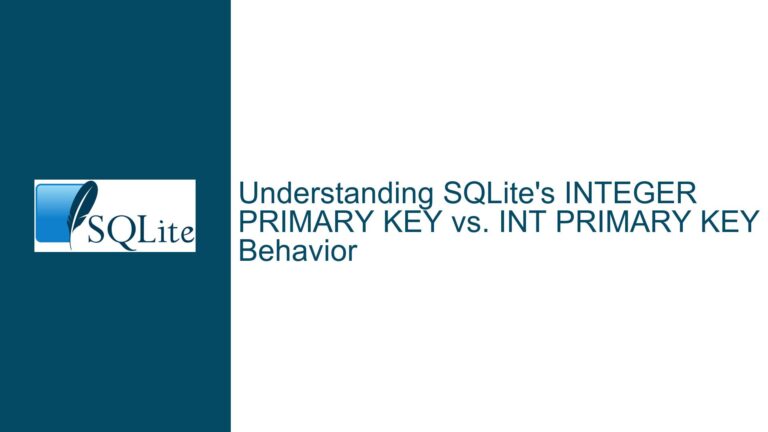SQLite Trigger Invocation Order and Behavior
Trigger Invocation Order and Determinism in SQLite
Issue Overview
In SQLite, triggers are powerful tools that allow developers to automate actions in response to specific database events such as INSERT, UPDATE, or DELETE operations. However, when multiple triggers are defined on the same table with similar conditions, questions arise about the order in which these triggers are invoked. Specifically, developers often wonder whether the sequence of trigger execution is deterministic or unpredictable. Additionally, there is confusion about how the WHEN clause is evaluated, especially when the execution of one trigger modifies the data in a way that could affect the conditions of subsequent triggers. Furthermore, the impact of the Recursive Triggers configuration on trigger invocation order and behavior adds another layer of complexity.
The core issue revolves around understanding the algorithm SQLite uses to determine the order of trigger execution, whether this order is consistent, and how runtime conditions (such as changes made by earlier triggers) affect the execution of subsequent triggers. This is particularly important in scenarios where the outcome of a series of triggers depends on their execution order. Misunderstanding these aspects can lead to unpredictable behavior in database operations, making it crucial to have a clear grasp of how SQLite handles trigger invocation.
Possible Causes
The ambiguity surrounding trigger invocation order and behavior in SQLite can be attributed to several factors. First, SQLite’s documentation does not explicitly state a deterministic order for trigger execution, leading to assumptions that the order might be based on the sequence in which triggers were defined. However, this assumption is not always reliable, especially when triggers are dropped and recreated, or when the database schema undergoes changes.
Another source of confusion is the runtime evaluation of the WHEN clause. Unlike the FOR, OF, and ON clauses, which are evaluated at compile time to determine whether a trigger should be considered for execution, the WHEN clause is evaluated just before the trigger is executed. This means that if a preceding trigger modifies the data in a way that affects the WHEN condition of a subsequent trigger, the outcome may differ from what was initially expected.
The Recursive Triggers configuration further complicates the matter. When recursive triggers are enabled, any database operation performed within a trigger can itself fire additional triggers. This recursive behavior can lead to complex chains of trigger invocations, making it difficult to predict the overall sequence of operations. The default setting for recursive triggers has also been inconsistent across different versions of SQLite documentation, adding to the confusion.
Lastly, the lack of explicit control over trigger execution order in SQLite means that developers must rely on careful design and testing to ensure that their triggers behave as expected. This can be challenging, especially in large databases with numerous triggers and complex interdependencies.
Troubleshooting Steps, Solutions & Fixes
To address the issues related to trigger invocation order and behavior in SQLite, developers can follow a series of troubleshooting steps and implement solutions that ensure predictable and reliable trigger execution.
1. Understanding Trigger Compilation and Runtime Evaluation:
The first step in troubleshooting trigger behavior is to understand how SQLite compiles and evaluates triggers. At compile time, SQLite checks the FOR, OF, and ON clauses to determine whether a trigger should be included in the set of potential triggers to execute. For example, if an INSERT operation is performed, only triggers defined for INSERT operations on the relevant table will be considered. This compile-time filtering ensures that only relevant triggers are included in the execution plan.
However, the WHEN clause is evaluated at runtime, just before the trigger is executed. This means that the condition specified in the WHEN clause is re-evaluated each time the trigger is about to run. If a preceding trigger modifies the data in a way that affects the WHEN condition, the subsequent trigger may or may not execute based on the new data state. This runtime evaluation can lead to unexpected behavior if not carefully managed.
2. Ensuring Deterministic Trigger Execution Order:
While SQLite does not provide a built-in mechanism to explicitly define the order of trigger execution, developers can achieve a deterministic order by carefully managing the creation and modification of triggers. One approach is to ensure that triggers are created in the desired order, as SQLite appears to execute triggers in the order they were defined. This can be verified by testing the trigger execution sequence in a controlled environment.
If triggers are dropped and recreated, it is important to recreate them in the same order to maintain the desired execution sequence. Additionally, developers should avoid modifying the schema in a way that could inadvertently change the order of trigger execution. For example, adding or removing columns or tables could affect the order in which triggers are compiled and executed.
3. Managing Recursive Triggers:
The Recursive Triggers configuration can significantly impact trigger behavior, especially in complex databases with multiple interdependent triggers. By default, recursive triggers are enabled in SQLite, meaning that any database operation performed within a trigger can fire additional triggers. This can lead to long chains of trigger invocations, which may be difficult to predict and control.
To manage recursive triggers, developers can explicitly disable recursive triggers using the PRAGMA recursive_triggers command. Disabling recursive triggers can simplify trigger behavior by preventing nested trigger invocations. However, this approach should be used with caution, as it may break functionality that relies on recursive trigger behavior.
Alternatively, developers can design triggers to handle recursive scenarios explicitly. For example, a trigger can include logic to detect whether it is being invoked recursively and take appropriate action. This can help prevent infinite loops and ensure that recursive triggers behave as expected.
4. Testing and Validation:
Given the potential for unexpected behavior in trigger execution, thorough testing and validation are essential. Developers should create test cases that cover all possible scenarios, including cases where triggers modify data in ways that affect subsequent triggers. These test cases should be run in a controlled environment to verify that triggers execute in the expected order and produce the desired results.
In addition to functional testing, developers should also perform stress testing to ensure that triggers perform well under heavy load. This is particularly important in databases with complex trigger logic, where performance bottlenecks can arise from inefficient trigger design.
5. Documentation and Best Practices:
Finally, maintaining clear and comprehensive documentation is crucial for managing triggers in SQLite. Documentation should include details about the purpose of each trigger, the conditions under which it is executed, and any dependencies on other triggers or database objects. This documentation can serve as a reference for developers and help ensure that triggers are implemented and maintained consistently.
In addition to documentation, developers should follow best practices for trigger design. This includes keeping trigger logic simple and focused, avoiding unnecessary complexity, and minimizing the number of triggers defined on a single table. By adhering to these best practices, developers can reduce the risk of unexpected behavior and ensure that triggers are easy to understand and maintain.
Conclusion:
Understanding the order and behavior of trigger invocation in SQLite is essential for developing reliable and predictable database applications. By carefully managing trigger creation, evaluating runtime conditions, and testing thoroughly, developers can ensure that triggers execute in the desired order and produce the expected results. Additionally, managing recursive triggers and following best practices for trigger design can help prevent unexpected behavior and maintain the integrity of the database. With these strategies in place, developers can harness the full power of SQLite triggers while minimizing the risk of unpredictable outcomes.






